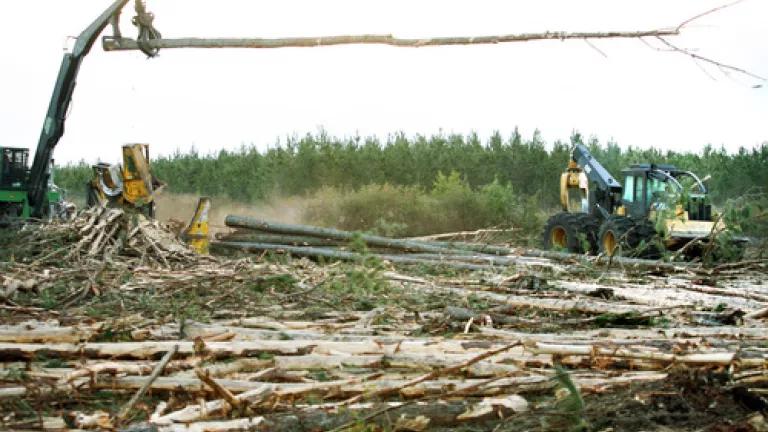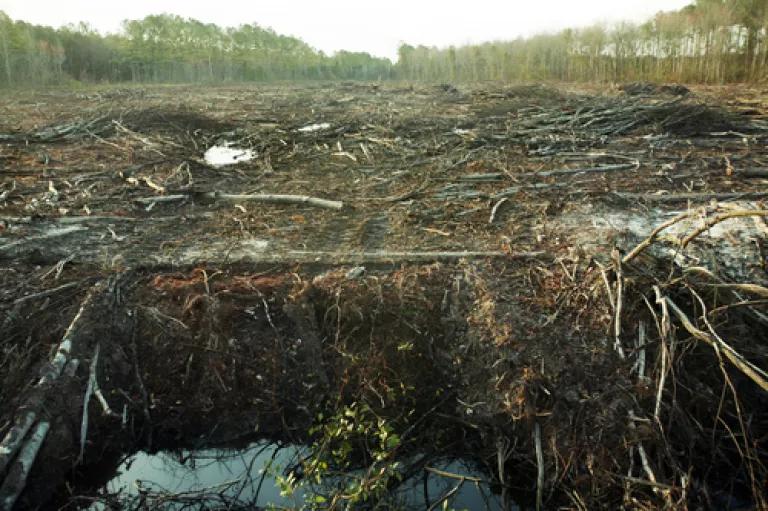New evidence that cutting forests to burn for electricity is even worse for the climate than we thought

Burning our forests for electricity is a bad idea—bad for our climate, bad for local ecosystems, and bad for our communities. But a new study just out of Dartmouth College shows that it might be even worse than we thought.
Multiple previous studies have focused on emissions of the carbon that’s stored in above-ground biomass (i.e. tree trunks, limbs, etc.) when that biomass is burned in a power plant. This new study looked at the carbon stored deep in forest soils and what happens to it when forests are chopped down to supply biomass to energy companies. Here’s what the researchers found:
"Our paper suggests the carbon in the mineral soil may change more rapidly, and result in increases in atmospheric carbon dioxide, as a result of disturbances such as logging," said Dartmouth Professor Andrew Friedland, a co-author.
"[This] suggests that increased reliance on wood may have the unintended effect of increasing the transfer of carbon from the mineral soil to the atmosphere. So the intended goal of reducing carbon in the atmosphere may not be met."
In other words, harvesting forests intensively disturbs the carbon in the soil, releasing large quantities of carbon dioxide into the atmosphere—on top of the carbon that’s emitted at the smokestack when the trees are actually burned. And according to the Dartmouth researchers, forest carbon analyses are incomplete unless they include deep soil, which stores more than 50 percent of the carbon in forest soils. This means that it is imperative that both utilities and policymakers account for this carbon when evaluating the climate impacts of substituting forest biomass for coal and other fossil fuels.
The idea that tree harvests have a profound impact on forest soils isn’t surprising. Clear-cutting, a common logging practice in the Southern U.S., isn’t pretty. To say that it disturbs the forest floor is an understatement:

The biomass energy industry—led by utility companies like the UK’s Drax Power and their wood fuel supplier, Enviva—promote woody biomass as a way to reduce carbon emissions in the power sector and mitigate climate change. Drax claims that smokestack carbon emissions can be ignored because they ensure that the ‘growth-drain’ ratio of their forests is more than one (meaning they plant more than they harvest so the carbon emitted when they burn trees is carbon those trees have sucked up out of the atmosphere and will suck up again when a new tree regrows).
This argument is erroneous for three key reasons:
First, just like fossil fuels, when trees are burned in power plants, the carbon they have accumulated is released into the atmosphere. However, because freshly cut wood is nearly half water by weight, a lot of energy is required to boil off this water before useful energy can be generated. This makes biomass facilities far less efficient than fossil fuel.
Second, cutting down trees for energy production disrupts vital carbon sinks and impedes ongoing forest carbon sequestration—not just on the forest floor, but deep down in the soil, as the new Dartmouth research demonstrates. From the perspective of the atmosphere, diminishing a carbon sink has the same impact as creating an equivalent-sized smokestack.
This new study joins a growing body of science that has clarified the need to distinguish between different sources of biomass and rapidly curtail the use of the highest carbon biomass sources—in particular whole trees—in utility-scale electricity generation. Four of the most well regarded studies are cited and linked to in the endnotes below[i], but here’s the gist of their findings: While there is some regional variability in results due to variations in climate and forest type, all four find that burning whole trees increases carbon emissions relative to fossil fuels for many decades—anywhere from 40 to 100 years or more.
We don’t have that long to wait.
Third, alternatives exist. Agricultural or wood materials that would otherwise end up in a landfill or burned—for example, the tops and limbs of trees—are more sustainable, lower-carbon sources of biomass. In addition, the use of sustainably grown energy crops has the potential to reduce carbon emissions without compromising the health of the soil or surrounding wildlife habitat. Investing in dirty whole tree biomass shifts resources away from these low-carbon biomass alternatives, as well as other truly clean energy sources like energy efficiency, wind, solar, and geothermal.
But you don’t need to be a climate scientist or energy sector analyst to understand that an industry that cuts down forests in the name of addressing climate change—and the policies that support that industry—just doesn’t make sense.
Already in the U.S., we count on our forests to suck up roughly 13% of our total, economy-wide greenhouse gas emissions each year. That’s like taking more than 180 million cars off the road. If we’re looking for creative ways to use our forests to tackle climate change, then we need look no further. Forests are already doing the very best thing they can do to help us in that effort. They are being forests: giant, super effective carbon sucking machines. Any alternative climate mitigation purpose we’d like to put them towards has to be compared to what would happen if we simply let them be.
So let’s let forests do what they do best while we Americans do what we do best: innovate and deploy the new, modern, and truly clean energy technologies we need to power our lives in the 21st century—energy efficiency, wind, solar, and bioenergy that’s actually low-carbon. These technologies create jobs, bring down our carbon emissions, and create healthier communities.
Want to solve climate change? Let forests be forests. Tell biomass energy companies that our forests aren’t fuel.
[i] Manomet Center for Conservation Sciences, Biomass Sustainability and Carbon Policy Study, June 2010; Oregon State University, Impacts of Thinning on Carbon Stores in the PNW: A Plot Level Analysis, May, 2011; The Biomass Energy Resource Center, Forest Guild, and Spatial Informatics Group, Biomass Supply and Carbon Accounting for Southeastern Forests, February 2012; Duke University and Oregon State University, Carbon debt and carbon sequestration parity in forest bioenergy production, May 2012.
